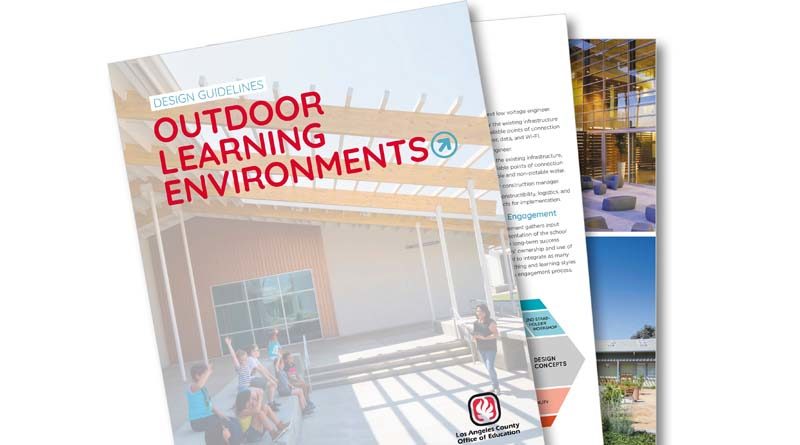HMC Architects Teams with L.A. County on Outdoor Learning Guide
By SCN Staff
LOS ANGELES—The COVID-19 pandemic has challenged educators to reimagine and be creative with outdoor space as a way to support the safe return to in-person instruction given the lower risk of virus transmission.
To help schools and facilities professionals create equitable everyday outdoor learning experiences on their campuses, the Los Angeles County Office of Education has published design guidelines through the support of HMC Architects and engineering and construction experts.
After spending the last year mostly indoors, isolated, and in front of a screen, it’s more evident now than ever that young students crave connectedness with the natural world, which offers a unique opportunity for cognitive and physical development.
In March of 2020 — during the advent of COVID-19 — HMC began a long and ongoing research effort to better understand the long-term effects of COVID-19 and develop solutions for the safer reopening of PreK-12 schools. One common solution was the need for more open-air spaces.
LACOE and HMC also found that while the pandemic has forced educators to innovate and be creative with outdoor space to lower the risk of virus transmission, there are numerous benefits — pandemic or not — that outdoor education provides.
“Outdoor learning offers students a range of benefits, from enhancing engagement to reducing stress and promoting physical and psychological wellbeing,” said Debra Duardo, Los Angeles County Superintendent of Schools. “Yet far too many of our young people, particularly those in inner-city and low-income communities, have not had access to outdoor learning environments and green space — not before nor during the pandemic. Increasing opportunities for outdoor learning is essential to advancing educational equity.”
Just as COVID-19 has disproportionately affected some populations more than others, this inequity is another educational injustice that the pandemic has exposed. According to LACOE and HMC, this inequity is an opportunity to seize the moment with strategies that place priority on meeting the needs of the whole child.
“The aim is not just to facilitate short-term COVID-19 solutions,” said HMC PreK-12 Practice Leader Brian Meyers. “We want to support the academic, social-emotional, and physical well-being of students and provide them with hands-on outdoor experiences during their school day long after the pandemic is over.”
Added Duardo, “When we take lessons outside classroom walls, we teach our children that learning can happen anywhere and anytime, promoting lifelong curiosity.”
It’s that curiosity that LACOE and HMC want to restore, as subjects like science either stopped or became limited for students through distance learning. Eighty-eight percent of teachers said that kids were learning less science during the pandemic. Pre-COVID, elementary teachers in California, on average, spent less than 60 minutes per week teaching science. According to LACOE, when students are surrounded by the outdoors, they become first-hand witnesses to natural processes. This direct observation is the first step in becoming a ‘natural scientist.’
With easy-to-use tools that can be customized for schools and districts, the guide covers everything from seating, sun shading, space definition, and landscaping to funding and professional development. LACOE and HMC see this as a chance to create new learning models. For example, schools can stagger classroom instruction with outdoor learning instead of the COVID-inspired hybrid model where students spend half the day in class and the other half at home.
To help reinforce the momentum toward safe, resilient learning environments that enhance student success, wellness, and community well beyond this current crisis, it’s clear that the benefits of making outdoor learning part of the normal routine are proven and can be the performance boost that our kids need right now.
The new Outdoor Learning Guide is available for free download at HMC’s website here: https://hmcarchitects.com/news/new-design-guidelines-for-outdoor-learning/
In addition to the Outdoor Learning Guide, HMC has also created a Campus Reboot Guide, and is committed to sharing all of its research findings in a series of white papers that focus on five main areas of Technology, Adaptability and Flexibility, Regulatory/Budgetary/Institutional Impacts, Space Needs/Reduction and Restructuring, and Impact to Wellness/Mental Health as they relate to the PreK-12 education sector.
These whitepapers can be downloaded here: https://hmcarchitects.com/research/

